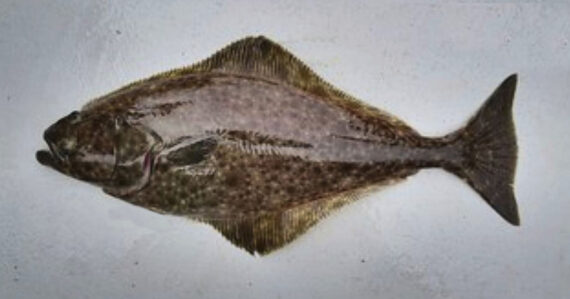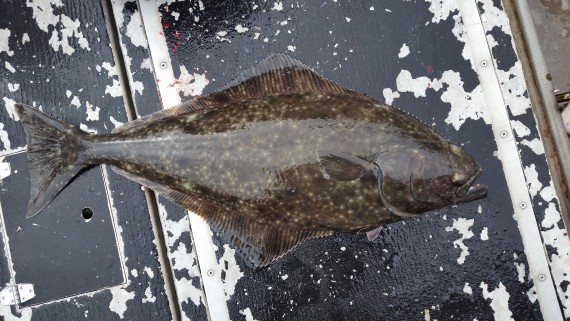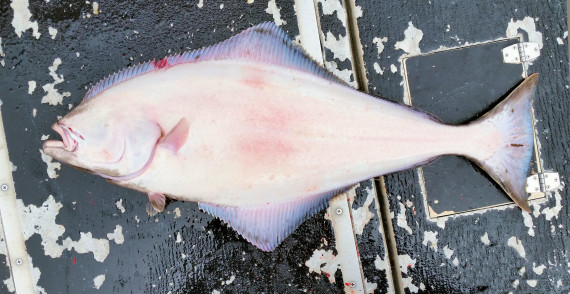Pacific Halibut, Hippoglossus stenolepis
 Pacific Halibut, Hippoglossus stenolepis. Fish caught from coastal waters off Sitka, Alaska, July 2014. Length: 1.07 m (42 inches). Catch, photograph and identification courtesy of Eli (obsessiveangling.wordpress.com).
Pacific Halibut, Hippoglossus stenolepis. Fish caught from coastal waters off Sitka, Alaska, July 2014. Length: 1.07 m (42 inches). Catch, photograph and identification courtesy of Eli (obsessiveangling.wordpress.com).

 Pacific Halibut, Hippoglossus stenolepis. Fish caught from coastal waters off Sitka, Alaska, September 2015. Photograph and identification courtesy of Chris Wheaton, Fullerton, California.
Pacific Halibut, Hippoglossus stenolepis. Fish caught from coastal waters off Sitka, Alaska, September 2015. Photograph and identification courtesy of Chris Wheaton, Fullerton, California.
The Pacific Halibut, Hippoglossus stenolepis, is a member of the Righteye Flounder or Pleuronectidae Family, and is known in Mexico as alabato de Pacífico. The larger specimens of this species are commonly referred to as “barn doors” and the smaller one as “chickens”. Globally, there are two species in the genus Hippoglossus, of which one, this species, is found in Mexican waters of the Pacific Ocean.
The Pacific Halibut has a diamond-shaped body that are flattened laterally and more elongated than most flat fish; their body depth is 31% to 35% of standard length. Dorsally they are dark gray to dark brown with mottling and numerous small spots that change color to match their substrate. Their blind side is off-white. They have a large oblique mouth that extends to the rear margin of their eyes and is equipped with 2 rows of conical teeth on their upper jaw and 1 row on their lower jaw. Their anal fin has 64 to 81 rays and extends from behind the anus to the base of the tail; their caudal fin is broad, symmetrical, and crescent-shaped or lunate; and, their dorsal fin is continuous with 89 to 109 rays that extend from the eyes to the base of the tail. They have 7 to 10 short and stout gill rakers on their lower arch. Their lateral line is strongly arched over the pectoral fin and they have small scales that are smooth to the touch.
The Pacific Halibut is a demersal species that is found over gravel and within sandy and muddy bottoms on the continental shelf of the North Pacific Ocean and Behring Sea at depths up to 1,100 m (3,600 feet). They are one of the largest flatfish in the world with females being fast growers and becoming much larger than males. Males are seldom greater than 1 m (3 feet 3 inches) in length and 27 kg (60 lbs) in weight. Females reach a maximum of 2.67 m (8 feet 9 inches) in length and over 1.5 m (4 feet 11 inches) in width. As of January 1, 2024, the International Game Fish Association world record stood at 208.6 kg (459 lbs) with the fish caught in coastal waters off Alaska in 1996. The weight of a Pacific Halibut is easily determined from its length via the “Weight versus Length Charts” available in the public domain. For example, a 51 cm (20 inch) fish weighs 1.4 kg (3 lbs 1 oz), a 91 cm (3 feet 0 inch) fish weighs 9.1 kg (20 lbs 0 oz), and a 1.5 m (4 feet 11 inches) fish weighs 45 kg (100 lbs). They are normally found in water temperatures between 3oC (37oF) and 8oC (46oF). They are strong swimmers and swim sideways with one side facing down and the other facing up. They are highly migratory with mature fish making annual seasonal runs between shallow waters in the summer for feeding and deeper waters in the winter for spawning; they have been documented to travel up to 3,200 km (2,000 miles). Juveniles feed on plankton; as they mature their diet changes to euphausiids (small shrimp-like crustaceans) and small fish. Adults are aggressive ambush predators and consume larger fish such as capelin, cod, herring, pollock, rockfish, sablefish, and smelt as well as clam, crab, and octopus. They are preyed upon by various marine mammals and sharks. Most spawn from November through March at depths between 183 m (600 feet) and 460 m (1,500 feet). Each female releases between 500,000 and 4,000,000 eggs. Eggs are fertilized externally by males and hatch in about 15 days with larvae becoming pelagic and traveling several hundred miles with the currents to shallower waters. They initially develop in an upright position like other fish with an eye on each side of the head. The left eye moves to the right side of the head when the larvae are about one inch long and five weeks of age. The eyes in only one in 20,000 fish fail to migrate. At the same time the dark color on the left side of the body fades and the body flattens into an oval shape. Juveniles settle out on the bottom near shore within six months and remain there until they reach sexual maturity five to seven years later. They have a lifespan of up to 55 years, a parameter that can be determined by counting the growth rings laid down in the “otolith”, a bony structure in their inner ear.
The Pacific Halibut is a resident of Mexican waters of the Pacific Ocean but have a very limited distribution being found from Punta Camalu, Baja California, northward along the northwest coast of Baja.
The Pacific Halibut is most likely confused with the Arrowtooth Flounder, Atheresthes stomias (coarse scales; needle-like teeth; slightly arched lateral line).
The conservation status of the Pacific Halibut has not been formally evaluated. They have been fished for hundreds of years by Native Americans along the Northwest Coast of North America. The commercial fishery began in the late 1800s and the majority are currently caught by commercial longline fishermen utilizing heavily weighted 100-hook strings at depths up to 600 feet that are laid on the bottom and soaked for up to 24 hours. This approach has reduced the impact of by-catch with the most significant casualties being seabirds that attack baited hooks as they are deployed. Annual catch levels are currently on the order of 50,000,000 lbs. They are also a mainstay of an expanding charter industry with a major focus in southeast Alaska from mid-May through mid-September with annual catch levels now approaching 8,000,000 lbs. They are a very popular sportsfish due to their size, strength, and meat quality. They require stout tackle normally needing 275 m (300 yds of 60 to 100 lb test line with weights up to 36 oz. Very large fish are difficult to land and historically a 22-caliber pistol, small shotgun, or harpoon have been used to subdue fish. Fillets will average 50% of the total fish weight. Their flesh is white with a mild flavor and is high in protein, minerals, vitamins, and omega-3 fatty acids; it can be stored on ice, frozen or preserved by drying or smoking and kept for long periods without spoiling. They are popular for cooking due to their mild flavor, sweet taste, and firm texture. There are reports that their mercury content may be of some concern. Subsistence fishermen catch approximately 1,000,000 lbs per year. They are a heavily regulated and monitored species with all waters of the Pacific Northwest having differing regulations that include daily bag limits, possession limits, seasonal closures, daily closures, and annual individual and/or ship quotas with apportionment based on geographic location for commercial, recreational, and subsistence fishermen. Stock assessments are also heavily monitored as a means to estimate stock abundance and trends. Population assessments indicate that they have been in serious decline from the 1990s but have seemed to stabilize since 2012. Overall they are considered a well-managed fish. One currently unresolved issue is that mature fish are becoming significantly shorter and lighter than fish caught 50 years ago, i.e. a 12-year old halibut is now about three-quarters the length and about half the weight of fish caught earlier. They do not have a swim bladder and it is believed that greater than 95% will survive “catch and release”.